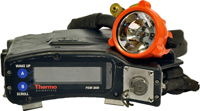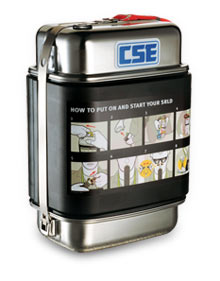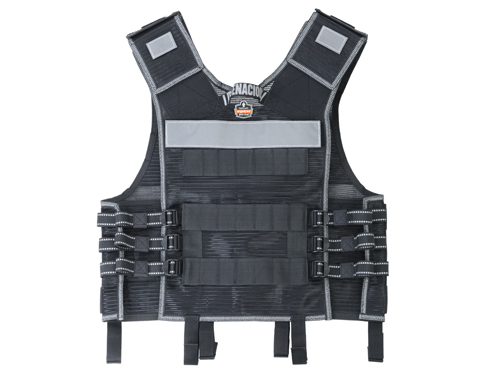Appendix P_Vest Usability Protocol
Appendix P_Vest Usability Protocol.doc
Assessing and Evaluating Human Systems Integration Needs in Mining
Appendix P_Vest Usability Protocol
OMB: 0920-0981
Project: Usability Testing of Commercially Available Mining Vest(s)
Project Leader: Jennica Roche, MS HSRB # 12-OMSHR-03XP
Appendix P: Vest Usability Protocol
Usability Testing of Commercially Available Mining Vest(s)
9/21/2012
RESEARCH SUMMARY
This protocol encompasses tasks for the NIOSH/OMSHR projects Human Systems Integration Design Guidelines (MinerFirst) for Improved Mine Worker Safety and New Technologies and Equipment for Mine Safety and Health. This research will be conducted by members of the Cognitive Engineering Team (CET) in the Human Factors Branch (HFB) of the Office of Mine Safety and Health Research (OMSHR). Spurred by recent mining disasters (Brookwood, Quecreek, Sago, Darby, Crandall Canyon, and Upper Big Branch) and ongoing heath initiatives (End Black Lung – Act Now), U.S. underground coal miners are required to carry an increasing amount of equipment. In fact, some miners are expected to wear and/or carry nearly 20lbs of personal protective equipment alone, not including the tools they need to actually preform their jobs. Currently, most personnel in underground mines utilize a mining belt to carry their equipment. However, this design provides limited space to attach the heavy and bulky equipment, and with pieces like the personal dust monitor (PDM) (6.6lbs) and self-contained self-rescuer (SCSR) (5.9lbs), the real estate and human capacity can be exceeded very quickly (Figure 1).


Figure 1: Examples of the belt-worn personal dust monitor (Thermo Scientific) and self-contained self-rescuer (CSE-SRLD)
Recently, a new option has entered the U.S. market, the mining vest. There is currently only one commercially available mining vest produced by Ergodyne®. This modular vest is based on the military adopted Modular Lightweight Load-carrying Equipment (MOLLE) system with the Pouch Attachment Ladder System (PALS). The MOLLE system is designed to provide flexible attachment of various pouches to accommodate numerous setups. However, there is limited information on the performance, usability, and acceptance of a modular vest in the underground mining environment. Therefore, the objective of this field evaluation is to perform usability testing on the Ergodyne® vest in the underground coal mining environment. Both high-seam (roof height of ≥61”) and medium to low-seam coal (roof height of ≤60”) will be targeted to ensure that the differing limitations of roof height are addressed.
To accomplish the objective of the study, usability testing will be performed on two groups of miners that represent various positions in a high-seam and medium-low-seam coal mine. Each group will contain nine miners that will be given an Ergodyne® mining vest to be worn and utilized for one month. NIOSH researchers will collect demographic information and subjective data from each miner before and after the testing period, through the form of a questionnaire, as well as provide a diary for weekly feedback while using the vest. The total time of commitment by the miners will be approximately 1.5 to 2 hours total (10 minutes for an introduction and consent, 10 minutes for fitting, 2x20 minutes for the pre and post-test questionnaire, and 4x5 minutes for the weekly diary questions).
This study will be performed independently from Ergodyne®, though we do plan on sharing the final report with the company. Ergodyne® will not have access to the participants or be otherwise involved in the study. The vests used in this study were purchased by NIOSH from a distributor and partnering company, Fairmont Supply. Fairmont Supply will be acting as a partner in this study (see form 1370) only by aiding in the fitting of the Ergodyne® vest. Fairmont supply will have no financial gain or any additional access to the data beyond the fitting session. They will only be given the final report as well.
Research Team
All tasks described in the protocol below will be performed interchangeably by all members of the team. Additionally, at least three members of the team will be present at each site visit.
Jennica Roche, MS
Lisa Steiner, PhD (about to defend)
Brianna Eiter, PhD
Justin Patts, BS
Brendan Demich
HSRB Issues
Risks
The activities of this study pose no more than minimal risk to human subjects. The addition of the vest poses no more risk than the subjects would otherwise face wearing their normal clothing, with the possibility of loose material hooking or snagging. However, the risks are minimized by the removal of all loose material as addressed in the vest modifications portion of this protocol.
Research Subjects
Underground coal miners in Somerset, Pennsylvania at the Roytown (medium-low-seam) and Sarah (high-seam) mines, owned by Severstal Resources, are interested in participating in the study. The desired participation is nine workers from each mine, spanning five to seven different job titles (see table below). Since the usability will be better highlighted by positions that are required to carry more equipment, the recruitment of volunteers will focus on two demanding positions: the fire boss and the continuous miner operator. However, subject participation is strictly voluntary.
Job Title |
High-Seam Subjects |
Low-Seam Subjects |
Fire Boss |
2 |
2 |
Continuous Miner Operator |
2 |
2 |
Roof Bolter Operator |
1 |
1 |
Shuttle Car Operator |
1 |
1 |
Mechanic |
1 |
1 |
Belt Man |
1 |
1 |
Roof Bolter Helper |
1 |
1 |
Subject Recruitment
NIOSH researchers have previously met with safety management from each mine to discuss vest safety, mine requirements for vest implementation, vest use, and evaluations that will be done by researchers, and the safety management has given their approval to allow several miners to wear a modified version of the Ergodyne® mining vest (see Vest Modifications). Mine management will suggest a group of mine employees that fit the desired job titles and the selection criteria of the study. NIOSH will then meet with the suggested employees and seek volunteers that would consent to participate in the study. This meeting will take place during shift change to allow access to two groups of miners, pre- and post-shift, that meet the job title goals presented above.
Field Evaluation Tasks
Once all the subjects have agreed to participate and been consented, NIOSH researchers will conduct a pre-testing visit to perform the following (1) a vest fitting demonstration, (2) initial vest setup documentation, and (3) pre-test questionnaire (appendix A & B). Throughout the month evaluation, subjects will also be asked to answer a few weekly questions and document any problems in a diary (appendix C). Finally, NIOSH researchers will return after one month to conduct (1) final vest setup documentation and (2) a post-test questionnaire (appendix A & B).
Vest fitting demonstration: On the pre-test visit, a demonstration of how to correctly fit the vest will be made by a Fairmont Supply representative. Fairmont Supply is a distributor of the Ergodyne® mining vest and would normally be available to aid in the fitting of the vest when bought.
Vest Setup Documentation: Each miner will be given the opportunity to setup the sizing and pouch configuration of the vest as he or she chooses. The initial setup will take place in the training room at the mine sites. The final setup used by a particular miner will be the result of all the changes each miner has made over the month of use. For both the initial and final documentation, each miner will don his or her vest, and NIOSH researchers will take four photos to document the placement and fit of the vest: front, back, right side, and left side.
Pre-& Post-Test Questionnaire: Because the working postures vary due to changes in roof height, a low-seam (appendix A) and high-seam (appendix B) height questionnaire has been developed. Each will be administered at the appropriate mine site to collect demographic and subjective data. The questionnaires found in appendix A & B will be given to the respective groups at both the pre- and post-testing sessions. NIOSH researchers will be present during the administration of the questionnaires to answer any questions that the miners may have. The questionnaires are being administered twice to prompt the miners to think about the questions during the month of testing and generate more true to life answers. No personally identifiable data will be collected from the questionnaires. The demographic and subjective data collection location will be at the discretion of the mine.
Weekly questions & Diary: The miners in both groups will also be provided with a small bound notebook containing the weekly questions and space to write down problems and thoughts during each week. The same weekly questions and diary will be given to each group as depicted in appendix C.
Benefits and Risks
The main benefit of the study for the miners will be to have the opportunity to try out the commercially available mining vest for one month for free. Additionally, the mine workers will have the opportunity to influence future designs of modular mining carriage systems through feedback. Risks to the subjects are not greater than the everyday hazards that mine workers are exposed to since the evaluation will occur during their regularly scheduled work, and the miners would be permitted to wear this vest underground if they purchased it independently.
Vest Modifications
The Ergodyne® vests used in this study will be slightly modified from the commercially available version at the request of the safety management of the Roytown and Sarah Severstal mines that have agreed to participate in the study. Namely, the belt loops and hanging hook will be removed (circled in dotted red) and an additional strip of reflective material will be added to the back of the vests (green rectangle). An Additional reflective strip will also be added to the front of the pouches.













Figure 2: Ergodyne vest modifications planned for the vest to be used in the current study. The dashed red lines encircle loops that will be removed and the added green region INDICATES a strip of reflective fabric that will be added.
Field Evaluation Informed Consent
After all the participants arrive at the group location, we will present each individual with a copy of the informed consent document and go over it with them, and then they will be given the option to choose whether they would like to participate. Upon agreement, the miners will then be given the option to take a copy of the consent form home with them for future reference. The consent form we intend to use is given in appendix D. The consent form is rated at a 12.2 Flesch-Kincaid Reading scale, which is acceptable since miners are required to have a high school level of education. Following the obtainment of informed consent, the miners will also be asked to sign a photo release waiver to enable the photo documentation of the vest setup (appendix E).
Reimbursement
No reimbursement will be offered for participation in this voluntary program. Subjects will participate during normal working hours, and they will be paid accordingly by their employers.
Data Management/Analysis Plan
The questionnaire data collected from this study will be stored on an encrypted hard drive, on a password-protected computer, locked in the principle investigator’s (PI’s) office. Only the PI and key personnel will have access to the data. No personally-identifiable information will be able to link the individual data sets with the participants. However, the setup documentation, questionnaire results, and vest will be linked with an identification number.
The quantitative data collected here will be analyzed using summary statics (mean, standard deviation, correlation) to understand the overall impression of the vest and its use. The qualitative data will be used to improve the design of a mining vest and develop further instruments to characterize the underground mining population.
Confidentiality
There will be no personally identifiable links between the questionnaire results and the subject. However, the setup documentation, questionnaire results, and vest itself will be linked via a subject ID number. The photo release waivers and consent forms that do contain personal information will be stored in a locked office, where only the PI and key personnel will have access.
Emergency Procedures
All posted emergency procedures will be followed. As the research will be conducted in the respective mines’ training rooms, no specific emergency procedures are required.
During the one month of use with the vests, mine employees will follow their normal emergency procedures.
| File Type | application/msword |
| Author | CDC User |
| Last Modified By | CDC User |
| File Modified | 2013-05-01 |
| File Created | 2013-04-23 |
© 2026 OMB.report | Privacy Policy